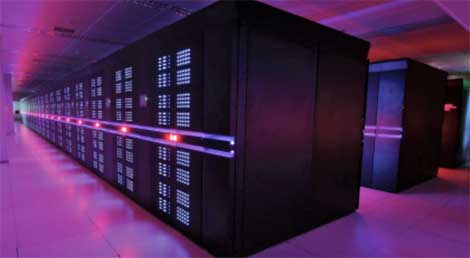
A look at the Milky Way-2 (Tianhe-2) supercomputer from China, the new champion in the Top500 list of the world's most powerful supercomputers.
Milkyway-2, a new supercomputer from China has blown the lid off of the semi-annual Top500 list of the most powerful supercomputers in the world. Announced at the International Supercomputing Conference in Leipzig, Germany Monday, at an astounding 33.86 petaflop/s the Chinese Milkyway-2 (also known as Tianhe-2) has almost doubled the performance of the November 2012 number one, Oak Ridge's Titan, which falls to number two on the June 2013 list.
The new champ's sister system, the Tianhe-1A at the National Supercomputer Center in Tianjin debuted at the number one spot on the Top500 list at 2.57 petaflops in November 2010, and took the tenth position with the same performance on the June 2013 list.
Developed by the Chinese National University of Defense Technology (NUDT) the new Tianhe-2 will provide an open platform for research and education, and is set to be online by the end of the year. Jack Dongarra from the Oak Ridge National Laboratory reported technical details of the TH-2 system on his visit to NUDT during an International HPC Forum (IHPCF) in Changsha China recently.
Intel Inside
There are 32,000 Intel Xeon E5-2600 v2 sockets and 48,000 Xeon Phi coprocessors for a total of 3,120,000 cores. The TH-2 system would represent the largest installation of Intel Ivy Bridge and Intel Phi processors. Phi is Intel’s Many Integrated Core (MIC) architecture for highly parallel workloads. Since it was released last year, it has been seen in several HPC projects, such as the TACC Stampede supercomputer. Stampede moved up a position on the June 2013 Top500 list, from number seven to number six.
Tianhe-2's 16,000 nodes will also boast a lot of memory - with 88GB per node, for a total of 1.404 petabytes of system memory. A proprietary optoelectronics hybrid transport interconnect technology and global shared parallel storage system containing 12.4 petabytes round out the specifications.
Powering such raw compute power is no easy task. Much of the issue in the race to exascale is adequately powering and cooling such intensive loads. A greater emphasis on efficiency and total power consumption of the Top500 supercomputers has reduced loads some, but there is still work to do if exascale can be achieved. The Tianhe-1A supercomputer consumed 4 megawatts of power in 2010 and every top spot in the Top500 list since then has consumed even more power - although several in the top rankings have managed to perform with less power. The TH-2 system will have a peak power consumption under load for the system of 17.8 megawatts. If cooling is added, the total power consumption 24 megawatts. With a cooling capacity of 80 kW the cooling system used is a closed-coupled chilled watercooling with a customized liquid water-cooling unit.
The rest of the list
The Department of Energy's Titan, a Cray XK7 system, remained at number two with 17.59 petaflop/s, and Sequoia dropped to number three. Moving up one spot on the June 2013 list the TACC Stampede supercomputer made significant improvements and clocked in at 5.168 petaflop/s. Vulcan - the fourth IBM BlueGene/Q system in the top 10, made a large jump from number 65 in November 2012, to number 8 on the June 2013 list, at 4.293 petaflop/s. Vulcan is a DOE supercomputer that debuted one year ago at number 48.
While China's Tianhe-2 vaulted to the top, the U.S. still leads the Top500 list with 252 systems. Europe has 112, and Asia 119 systems. Eighty-eight percent of the systems use processors with six or more cores, and 67 percent with eight or more cores. Use of accelerators or co-processor technology went down slightly, with 39 using NVIDIA chips, 3 using ATI Radeon, and 11 systems using Intel Xeon Phi.
The International Supercomputing Conference will continue this week, and the conversation can be followed on Twitter hashtag #ISC13.





